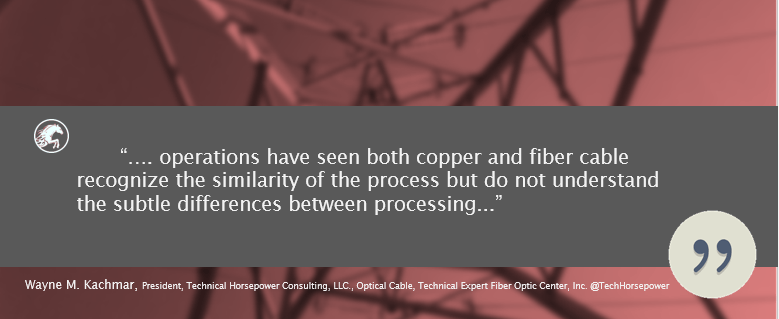Are all cable lines alike?
I’ve heard this many times before and typically it’s from operations type folks who have seen both copper and fiber cable operations recognize the similarity of the process but do not understand the subtle differences between processing a malleable material such as copper and a crystalline structure such as glass.
I’ve heard many folks tell me they don’t understand why you cannot produce optical fiber cable and copper cable side-by-side on the same equipment.
In order to look at this accurately, let’s start with some of the physics involved.
- Copper is a malleable metal that can be drawn or stretched, is relatively strong, has a relatively low thermal expansion and acts as a heat sink to the polymer during the extrusion process.
- Glass optical fiber on the other hand is an engineered crystalline structure consisting of many layers and materials. We have a glass and optical index of refraction additives in the core and cladding surrounded by the various ultraviolet cured acrylate polymers that make up the optical fiber coating. This engineered assembly does not like stretch and in fact, any strain shortens the optical glass lifetime. Due to the crystalline nature of glass, there is no sheer strength in the fiber.

Ever see how delicate a stemmed glass is if you knock it the wrong way? Because most optical fiber is typically UV coated, which acts as a thermal insulator, there is almost no absorption of heat by the fiber. This physically causes many problems with polymer extrusion as differential cooling causes many issues in post extrusion stress.
With these physical differences in mind, we need to recognize that many of the components look the same. You have an extruder which is a plastic melting pump a water trough that cools the plastic and a capstan that pulls the material through at a fixed rate. And there is typically a form of diameter control with some form of controlled payoff and take-up devices.
In copper manufacture, the copper conductors are the strength members in many of the cable designs. The optical fibers on the other hand while very high tensile strength glass, are extremely small and highly susceptible compressive and to off-axis stress.
When we look at optical fiber processing, we recognize that in both copper and fiber we are basically squirting plastic over a conductor. In one case, an electrical conductor, and in the other an optical conductor. To the untrained eye, this looks like the same process. In reality, we are actually doing totally different processes. In most copper extrusions we are insulating or coating the copper conductor using a direct contact application of plastic.
In optical fibers, we are mechanically buffering the optical fibers from outside handling. While these differences seem almost academic in nature they make a significant difference in how the process line is configured and operates.
In addition, the environment in which copper and optical cable are produced is different. Dust and contaminants for optical fiber as well as moisture can create problems for material that does not restrain polymer shrinkage. In copper insulation, thermal heating (preheating) helps maintain a good mechanical bond to the surface since the copper material itself acts as a heat sink and controls shrinkage without affecting its ability to conduct electrons. The same effect in optical fiber will cause compressive strain on the glass which is an engineered component. This would cause a significant stain and attenuation increase in overcooling and subsequent thermal cycling.
As a result other than the extruder, water trough, capstan combination, very little is held in common between copper and optical fiber process lines. And even these have subtle differences such as in screw, crosshead, and tooling design. There are many differences in the water trough processes and location as well as subtle differences in the control logic and surface finish of the capstans.
The pay-off and take-up equipment may look similar in that we are paying off material and taking up material under controlled tensions but in reality, the design and properties used for optical fiber and copper vary widely. In this instance, we are using two different properties to correctly handle the different materials.
As we compared to copper and fiber process lines we also need to recognize that premise or tight buffer cable and loose tube cable are processed on significantly different process lines. The ancillary equipment and methodologies are drastically different and while many manufacturers have adjustable components to make the process lines capable of producing both loose tube and tight buffer, in doing so, one or the other product line is sub-optimized.
When looking at adding optical fiber processing to a cable plant or adding a different product line such as tight buffer, one needs to be very thoughtful in several categories such as which product will be optimized, Product run time or change over time and what the environment will be required for manufacturing. For example will temperature and humidity need to be controlled and will the process be continuous or Job Shop.
So what looks like the same thing under the surface has many differences.



